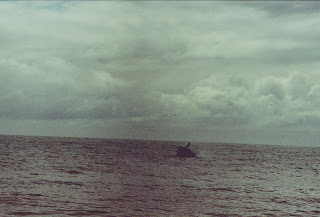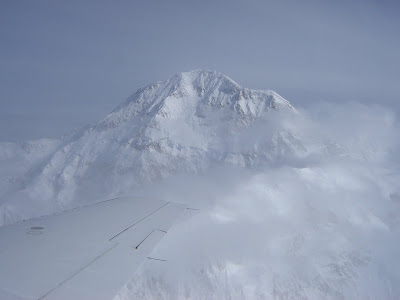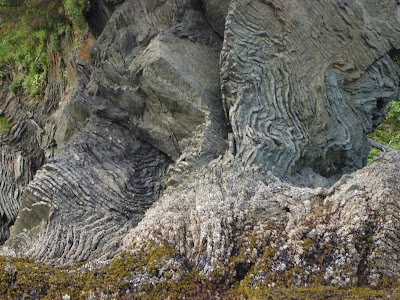12.01.2008
Sights and Sounds of a Typical Day for Amanda
10.13.2008
Alaska - Truly Mystical




 Begin the cruise! Tons of gorgeous waterfalls cascading down the mountainsides as the glaciers melt above. And, yes, the water is really that shade of blue-green (it's also about 40 degrees in temp - don't fall in!).
Begin the cruise! Tons of gorgeous waterfalls cascading down the mountainsides as the glaciers melt above. And, yes, the water is really that shade of blue-green (it's also about 40 degrees in temp - don't fall in!). Our first large glacier. Here we are about one mile away from the face which towers over 600 feet. This was the most active glacier that we saw.
Our first large glacier. Here we are about one mile away from the face which towers over 600 feet. This was the most active glacier that we saw. Here you can see the entire face of the glacier crashing into the water. It was the largest calving that the tour company has seen. It created a surge of water probably 8 feet high, threatening to topple over our cruise boat. We high-tailed it out of there, some people seeing visions of the fate of the Titanic. It was breath-taking.
Here you can see the entire face of the glacier crashing into the water. It was the largest calving that the tour company has seen. It created a surge of water probably 8 feet high, threatening to topple over our cruise boat. We high-tailed it out of there, some people seeing visions of the fate of the Titanic. It was breath-taking. Moose! Unfortunately, this one is in a wildlife refuge, but it looks like a National Geographic photo (sort-of!).
Moose! Unfortunately, this one is in a wildlife refuge, but it looks like a National Geographic photo (sort-of!).


 Sea Lions...
Sea Lions... Humpback whales breaching....
Humpback whales breaching.... Sleeping humpback whale
Sleeping humpback whale Bird rookery (bird habitat where they create a hierarchy, closest to the water being the lowest rank)...
Bird rookery (bird habitat where they create a hierarchy, closest to the water being the lowest rank)...



 I will definitely need to add videos in a future blog. We were so overtaken with awe on our adventure that we barely took any photos and pretty much all video. Soon to come!
I will definitely need to add videos in a future blog. We were so overtaken with awe on our adventure that we barely took any photos and pretty much all video. Soon to come!



The plane went to 21,000 feet to view the summit of Mt. McKinley (known as Denali in Alaska). We were able to see the camp where all the mountain climbers were resting due to a recent blizzard and sub-zero temps. The pressure in the plane was so great and the elevation was enough to make me ill. Both Joseph and I felt numbness and tingly in our arms and legs, a bit of dizziness, and an icky stomach. But, no casualties! We landed safe and sound, having experienced the summit of Denali minus the frostbitten toes and frozen eyelashes.



 Wrapping up our time in Alaska was bittersweet. As we arrived in Anchorage, cold and rainy, we realized that we were leaving a place that could have been "home." We weren't ready to leave, didn't feel like we should leave, and yet our lives were calling us back to North Carolina. We made some final stops in Anchorage, watching windsurfers in the bay, going for a walk, picking wildflowers (shhh, don't tell anybody, I don't think we were supposed to). We will be back. There is no question.
Wrapping up our time in Alaska was bittersweet. As we arrived in Anchorage, cold and rainy, we realized that we were leaving a place that could have been "home." We weren't ready to leave, didn't feel like we should leave, and yet our lives were calling us back to North Carolina. We made some final stops in Anchorage, watching windsurfers in the bay, going for a walk, picking wildflowers (shhh, don't tell anybody, I don't think we were supposed to). We will be back. There is no question.

9.23.2008
A New Addition to the Sand Family
8.31.2008
An Interesting Post on Driving Behavior
A new book out examines how different cultures help determine different driving habits. The book, "Traffic," by Tom Vanderbilt, states, for example, that drivers honk their horns all the time in Mexico but they don´t in Los Angeles. Countries like France and Belgium have more accidents than other European nations because they issue fewer traffic tickets.
The psychology of driving is such that it tends to make us anonymous, and that permits many people to behave more rudely with their cars than they ever would in face-to-face contact. But conversely, a broken traffic light generally returns us to polite social behavior as we take turns going through the intersection.
One theory presented that I´ll heartily agree with is that improvements in car safety have prompted people to drive more aggressively, resulting in more accidents. I would add that the explosion of SUVs on the road has added greatly to that tendency.
What does this have to do with the environment? Driving fast, accelerating and stopping, idling in congested traffic -- these are all great and largely underrated gas guzzling causes, which of course contributes hugely to carbon dioxide entering the air, resulting in pollution and global warming.
One interesting suggestion is congestion pricing, which would charge people to drive into high traffic areas. Such a fee might reduce traffic congestion -- and would help the environment as well.
Much of Vanderbilt´s book focused on the correlation between aggressive driving and safety, which involves environmental management as well. Safety and garbage trucks is a huge ongoing issue, and one of the problems is how the trucks affect the traffic around it. Aggressive driving to go around a waste truck leads to increased accidents.
If we really want to reduce our fuel consumption, we have to change behavior that´s ingrained in the American fabric. And driving fast will be one hard habit to break.
8.30.2008
8.29.2008
Living Green Expo - St. Paul, MN
8.28.2008
Link to Track Where Your Food Comes From
6.18.2008
Into the Wild!
6.08.2008
It's no fun being sick
Support Your Local Farmers!
This posting below really rang true with mine and Joseph's passions right now. It should be a focus for all of us. The only way to make change is to support local foods, local farms, buy organic when possible, and plant your own garden. One of the most patriotic things you can do is to have your own garden and provide some of your own food. Eating from your own garden also lessens the crunch on your bank account. You also know exactly what sort of chemicals or additives you use on your produce (I recommend not using any, just some manure, vermicompost(the website isn't mine, although it's coming!), and a good organic leaf mulch). Count how many fruits, vegetables, and other daily staples (and unnecessary calories added to our bodies) are from a different country. Herbicides, pesticides and fungicides that have been banned for decades (remember DDT?) are still being used in these countries. Join a Community Supported Agriculture program/farm in your area. They will deliver a box of fruits and veggies that are in season to your doorstep. Join the Slow Food Movement. Shop at your local farmer's market. Eat in season and eat a diverse range of foods and food groups. Your body is a temple. Eat to Live, not Live to Eat.
Take Note, Rome: Loss of Biodiversity and Sustainable Farming Practices Are Big Contributors to Hunger. Commentary by Gonzalo Oviedo, BBC News, June 2, 2008.
"We have a global food crisis... Unsustainable agricultural policies and technologies, inequitable trade rules, agricultural subsidies that distort the markets, and the systematic marginalization of small producers lie at the heart of [it]... [along with] chronic under-investment in agriculture in developing countries, and a real neglect of the basic premise that ecosystems have to be in good shape... The... massive expansion of agriculture [over the past 50 years]... has left us with 60% of all ecosystem services degraded, accelerated species extinction, and huge loss in genetic diversity. Currently, four plant species -- wheat, maize, rice and potato -- provide more than half of the plant-based calories in the human diet, while about a dozen animal species provide 90% of animal protein consumed globally. We have already lost three-quarters of the genetic diversity of agricultural crops. As the agricultural frontier has expanded, those farmers previously dependent on [more diverse crops] have converted to cash crops. As traditional varieties and breeds die out, so too do the traditional knowledge and practices of local farmers. Those same practices could now be critical in adapting to climate change." Gonzalo Oviedo is senior advisor on social policy with the International Union for Conservation of Nature (formerly the World Conservation Union).
My boss has just published his second book and it talks about just this concept. It is called "Small is Possible: Life in a Local Economy." Check it out here. Amazing. Inspiring.
2.16.2008
She's got worms!
In the greenhouse we built, we have the first permitted vermiculture project in North Carolina. That's a big deal. There are other operations that exist in the state but do not have the proper permits to allow them to market and sell their end product in accordance with state guidelines. It's very exciting and I try to hold the project to a high standard to maintain that sort of prestige that comes with being 'the first' in anything.
So, on this glorious day we held our worm workshop. Thirty eager bodies absorbed as much as they could on composting basics and worm care-taking. An excellent time was had by all. Brian did a fantastic job with the presentation. It is part of his job description to go around and do these talks so he has done the same spiel hundreds of times. I hope to be able to get to that point. Here is a link to photos from the event (it also goes to a flier for our next workshop coming up on April 5th):
http://gallery.mac.com/tschwerin#100176
Can't wait until the next workshop!











